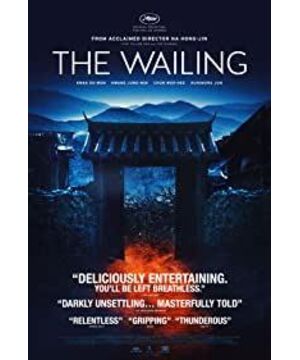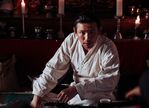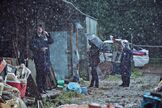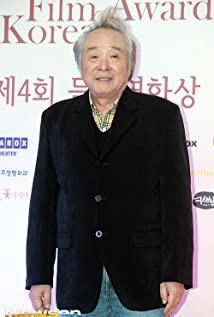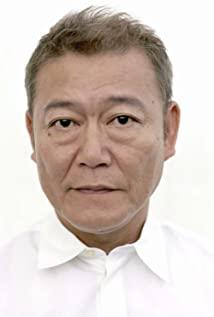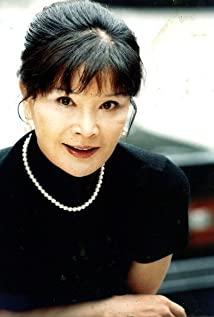In the first narrative shot of the film, the Japanese pulled up the hook. There was no bait on the hook, and there was no fish. He pursed his lips helplessly and began to hook a bait on the hook. His lips moved slightly, as if say something.
In the last shot, the policeman sits weakly on the ground with his back against the wall, with scars and exhaustion on his face, the picture fades away, and the film ends.
A crazy, mysterious story happened in the two and a half hours in between.
Which is evil and which is good? What does the director want to express? What is the purpose of the photo? What are the motives of the several forces? What does the mask in the box do? Who controls bird droppings and moths? Why is the unknown woman wearing the clothes of the dead? Who are the black and white male and female photos and the headless Bodhisattva? How did the hunter escape at the hands of the demon? What happened to the stigmata on the hands of the Japanese? How to explain the sound of the roof of the police daughter's room? Why did the body of the black sheep appear at the same time as the snapdragon?
Neither at the story level nor at the creative intent level, we can't directly draw the answer from the content provided by the film.
The village built by the director for the film is like an isolated island. They use smartphones and get news from newspapers; there are continuous murders, but there is no more high-level police investment; Gucheng Police Department A large number of reporters were in front of the door to inquire about news, but the media disappeared in this questionable village; the new deadly disease did not attract any official attention. The government system and the media were introduced in a very limited way, and then more thoroughly stripped.
Five tragedies occurred in this detached village.
In the first case, the Zhao couple who were growing ginseng were killed. The police judged that the murderer killed Zhao’s wife in the warehouse, and then dragged the body to Zhao’s home to kill Zhao’s. Withered snapdragons appeared outside the warehouse door, implying that the "trap" of the unknown woman failed for the first time. There are burning candles in the warehouse, and bird's nests like barbed wire, and the incense burner beads are scattered on the ground. Afterwards, the murderer died of a fractured bone in the hospital.
In the second case, a fire broke out in the mad woman's house. The mad woman and another man in her house had violent cannibalistic tendencies. The next day, the mad woman killed her family and hanged herself. This crazy woman was considered by the police to be a rainy naked woman, and his friend revealed that the woman had been raped by the Japanese.
In the third case, farmer Park Chunfei had just finished exorcism at his home. His family was thrown into a well by him, and he himself died on a truck in the mountains. Later resurrected, similar to zombies, attacked the police and others, and finally died of a fractured bone.
In the fourth case, the police partner killed the homeowner's grandmother.
In the fifth case, the police daughter killed her grandmother and mother.
The escort girl who was believed to be dying and had acne on her body did not explain the result. The last time she appeared was when the police were disposing of the Japanese bodies. At that time, the escort girl was sitting with another old woman. in front of the wizard.
Luo Hongzhen made it clear in the interview that the Japanese and the wizards were a group from the very beginning, and the "same underwear" and "photos" were his tools to establish the connection between the Japanese and the wizards, and his eyes changed when he finally shouted. The nameless woman who became "green" is a patron saint in his heart.
When the audience asked "why only the father survived in the family", the director explained the reason very seriously. But at the end of the film, the daughter's eyes are dull, sitting in front of the door, occasionally twitching, the father is sitting in the room where his wife and mother died, and in his weak mind is the good time spent with his daughter. From the image alone, It more clearly points to the result of the death of the father and the temporary survival of the daughter, and the daughter who is possessed may eventually die of bone fracture. If only the policeman survived as the director explained, then the nameless statement of the patron saint that "the whole family will die when they go back" is completely denied, and it is very doubtful whether the director knows what he shot.
On the other hand, the photos in the Japanese home show that he would take pictures three times when the victim was alive, after going mad, and after he died, and he would also collect the items of the living. photo, but it is clear that the daughter is the victim of being possessed.
The police found a lot of pictures on the daughter's exercise book. The first picture is of a little girl standing with a man. The second picture shows the girl bleeding from her genitals, her eyes turning red, she seems to have lost her virginity, and the image of the girl is bleeding from her genitals. Appeared twice, which may suggest that the daughter was violated by the Japanese multiple times. Then came the hanged woman, the male symbol, the man eating animal flesh, the woman bleeding from her genitals, and the terrified bystander girl.
One of them shows the Japanese demon image at the end of the film, with horns, pointed ears, blood-colored eyes, fangs, and claws. Next to the demon image is a flashlight and a cross. Why did the girl expect this scene? When she picked up the paintbrush, was it her own identity or the identity of the possessed evil spirit? Did she foresee this scene, or saw it with her own eyes, or imagined it? Demon claws have never been seen in previous descriptions.
When her father asked her if she had seen Japanese with her shoes, she angrily shouted at her father, "You don't even know what the most important thing is!" When she found out that her father was checking her body, The girl fell into madness again, which was more like the amplification of her own emotional response than the possession of evil spirits.
The director admitted frankly that he wanted to talk about "the reason why victims are victims" rather than mysterious religions. Ordinary people's cognitions are different. We don't know the reason for our existence, but we know that we will die for some reason.
"Why is a victim a victim", the director gave the two most direct answers through the actor's mouth:
"Do you know what is biting the bait when you are fishing?
Because your daughter's father was guilty, suspicious of others and wanted to kill, and ended up killing. 』
One is a useless answer full of fatalism, and the other is a useless answer that reverses cause and effect. This is the feedback the director received in real life. He copied it into the movie, and greatly exaggerated the sense of useless fate and downplayed the perpetrator's purpose. The first time the Japanese revealed the purpose of killing was in the description of a police friend. He accused the woman with whom he had had a close relationship with him as “dirty and lewd” by the river. Debauchery took the bait, so why did the man who killed the Zhao family, the farmer who killed his family, the police partner who killed the homeowner, and the policeman's daughter take the bait? When the perpetrator is embodied and clarified, the reason for the victimization is equal to the reason for the perpetrator. The bait is designed to point, and the director avoids talking about it.
When the police pushed the Japanese body off the cliff, the wizard said: This fool actually bit the bait. But at that time the Japanese fell off the cliff in the nameless chase, and prompted the police to complete the result of "suspecting others and wanting to kill, and finally killing them", when the nameless was looking down on them from the mountain, there is an irreversible contradiction.
In addition, the director also introduced the concept of "believe", who is the devil? Who is the murderer?
The four scenes of the exorcism ceremony are cross-edited, creating the illusion that the wizard is targeting the Japanese; the Japanese calmly said "you won't believe what I say", and ran away in difficulty and panic when facing the pursuit of the police and everyone, and fell off a cliff Weeping bitterly; Anonymous hits the wizard before the truth is revealed. The wizard appears mysterious and evil, and the suspicion of holding the victim's clothing is deepened...
At the end, the police face the choice of "believe". In his hesitation, he did not follow the wizard's words to go home immediately, nor did he follow the anonymous words and go home after three roosters. The police ran home before the third crowing, and his wife and mother were already in a pool of blood. If you believe in a wizard and get home before his daughter shows up, can he stop a child who can kill two grown women? Even if he came home after three roosters, his wife and mother could not survive. The only thing that is certain is that although he went back early, he was not destroyed as Wuming said. So who does the director want the audience to believe?
Whether you believe that the culprit is poisonous mushrooms, or nameless, or agree with the director's settings, or come up with other ideas, there are all kinds of details that hinder the truth you choose.
No matter how a drama film plays with the narrative, it should ultimately present a process of interlocking, rather than forcibly revealing one's identities after one after another. The director's unreasonable choice of plot led to a film with a narrative failure, and the Asian political and religious issues pointed to behind it did not have the basis for serious consideration.
Using the "God's Perspective" to shoot a film that is not anti-genre in the framework of a suspense film, but does not fully tell the story. And foreign media, who claim to be unable to distinguish Asian faces, how can they experience shock and beauty in this movie with a mix of characters and religions from the East and the West? Or are they just a bunch of loyal fans that can be captured with just the mystical landscape of the East?
A policeman left after breakfast in the early morning of the murder; the murder weapon at the crime scene was picked up by his bare hands without any protective measures; the murders happened one after another, and the leader accused his subordinates of being late and not washing the car. From "The Chaser" to "The Yellow Sea" to "The Cry", Luo Hongzhen's ambitions have expanded step by step, and his control has been reduced step by step. Only the heart of the "black police" remains unchanged.
He said in the interview that "I couldn't sleep well for about 3 years" because the later stage of the first edition of "Yellow Sea" was not well done. I don't know if one day in the future, if he re-watches "The Cry" full of dry howls, he will never lose sleep.
View more about The Wailing reviews


